Sud Aviation Caravelle
| Caravelle | |
|---|---|
 | |
| Inflight Air France Caravelle III | |
| Role | Narrow-body jet airliner |
| National origin | France |
| Manufacturer | Sud Aviation |
| First flight | 27 May 1955 |
| Introduction | 26 April 1959 with Scandinavian Airlines |
| Retired | 2005 |
| Status | Retired |
| Primary users | Air France Scandinavian Airlines Swissair Finnair Sabena Thai Airways |
| Produced | 1958–1972[1] |
| Number built | 282 |
| Unit cost |
-12: US$5.5M (1972)[2] |
The Sud Aviation SE 210 Caravelle was a French short/medium-range jet airliner. It holds the distinction of being the world's first jet-powered airliner to be developed for the short/medium-range market.
Development of the Caravelle began during the early 1950s under the French aircraft company SNCASE, who were keen to produce a passenger aircraft that utilised newly developed jet propulsion technology. In order to achieve this, SNCASE formed partnerships with British companies such as de Havilland (who provided designs and components which had on their jet-powered airliner, the de Havilland Comet) and Rolls-Royce Limited (from whom the Caravelle's Rolls-Royce Avon turbojet engines were sourced). While much of the airliner's development, including its maiden flight on 27 May 1955, was conducted under SNCASE; by the time that the Caravelle entered revenue service on 26 April 1959, the firm had been merged into the larger Sud Aviation conglomerate.
Within a few years of commencing passenger services, the Caravelle became one of the most successful European first-generation jetliners. The airliner achieved substantial sales to operators throughout Europe and even managed to penetrate the United States market, United Airlines placing an order for 20 Caravelles.[3] The Caravelle established the aft-mounted engine, clean-wing design configuration that is still used by smaller jetliners.[3]
Development
Origins
On 12 October 1951, the Comité du matériel civil (civil aircraft committee) published a specification for a medium-range aircraft, which was later sent to the aviation industry by the Direction technique et industrielle. This called for an aircraft capable of carrying 55 to 65 passengers and 1,000 kg (2,200 lb) of cargo on routes up to 2,000 km (1,100 nmi; 1,200 mi) with a cruising speed of about 600 km/h (320 kn; 370 mph). The type and number of engines were not specified. Since 1946, various design studies for aircraft in this category had already been underway at several of the leading French aircraft manufacturing organisations, and had resulted in some ambitious concepts being mooted. However, none of these firms possessed the financial power to independently embark on the substantial development work involved, let alone to establish a manufacturing line for the construction of such aircraft.[3][4]
The response to the specification from the French industry was strong, it has been claimed that every major manufacturer submitted at least one proposal; a total of 20 different designs were ultimately received. The majority of these proposals were powered by all-turbojet engine arrangements, although Breguet had entered a number of designs that were powered by both turbojet and turboprop engines; among these was one for an Snecma Atar-powered tri-jet to be developed in association with the SNCA du Nord and a turboprop type, all of which being designated as Br. 978. Hurel-Dubois had entered several turboprop designs based on a narrow fuselage and shoulder-mounted wing, similar to many regional propliners. Proposals from the SNCA du Sud-Ouest included the S.O.60 with two Rolls-Royce Avon RA.7 engines, outfitted with two smaller Turbomeca Marborés as auxiliaries. SNCA du Sud-Est (SNCASE) had also returned a number of designs from the X-200 to X-210, all of these being purely jet-powered.[3]
On 28 March 1952, after studying the various entries, the Comité du Matériel Civil announced that it had produced a short list of three entrants: the four-engined Avon/Marbore S.0.60, the twin-Avon Hurel-Dubois project, and the three-engined Avon Sud-Est X-210. At this point, British engine manufacturer Rolls-Royce had already begun to offer a new version of the Avon that was to be capable of developing 9,000 lbf (40 kN) of thrust, which would render the auxiliary engines of the S.O.60 and the third engine featured on the X-210 unnecessary.[3] The Committee issued a request for SNCASE to re-submit its X-210 proposal as a twin-Avon design.[4] In doing so, they decided not to bother moving the remaining engines from their rear-mounted position; most designs had placed the engines underneath the wing, where they could be mounted on the spar for lower overall weight, but SNCASE felt that these weight savings were not worth the effort. This turned out to be a benefit to the design, as the cabin noise was greatly reduced as a result. In July 1952, the revised X-210 design with twin Avons was re-submitted to the SGACC.[3]
Selection
%2C_Dublin%2C_February_1993_(02).jpg)
Two months later, SNCASE received official notification that its design had been accepted. On 6 July 1953, the SGACC placed a formal order for the construction of a pair of prototypes along with a pair of static airframes for fatigue testing. Sud's design licensed several fuselage features from British aircraft company de Havilland, whom Sud had already made previous dealings with in respect to several earlier designs. The nose area and cockpit layout were both taken directly from the de Havilland Comet jet airliner, while the rest of the airliner was locally designed.[3] A distinctive design feature was the cabin windows in the shape of a curved triangle which were smaller than conventional windows but gave the same field of view downwards.
On 21 April 1955, the first prototype of the Caravelle (F-WHHH), christened by Madame de Gaulle, was rolled out. On 27 May 1955, the first prototype conducted its maiden flight, powered by a pair of British Rolls-Royce RA-26 Mk.522, capable of providing 4,536 kgf (44,480 N; 10,000 lbf) of unitary thrust. For the maiden flight, which had a total duration of 41 minutes, the crew consisted of Pierre Nadot (first officer), André Moynot (second officer), Jean Avril (mechanic), André Préneron (radio operator) and Roger Beteille.[3]
Almost one year later, on 6 May 1956, the second prototype made its first flight. The first prototype had been fitted with a cargo door located on the lower left side of the fuselage, but this door was removed in the second prototype in favour of an all-seating arrangement.[3] By October 1956, both prototypes had accumulated in excess of 1,000 flight hours.[4] By the end of 1956, the two aircraft had visited various locations across Europe and North Africa, and trials were already underway for French carrier Air France. During 1957, the second prototype accumulated roughly 25,000 flight hours across various flights conducted throughout North America and South America.[4]
In 1956, the type received its first order from Air France; it was followed by SAS in 1957. More orders followed, which had been partially driven by a campaign of direct presentations held at airshows and dedicated flight demonstrations using the two prototypes to potential customers.[4] Also during 1956, Sud-Est had merged with Sud-Ouest and several other French aircraft manufacturers to become Sud Aviation; however, the original SE designation assigned to the airliner was retained.[4] In May 1959, the Caravelle received its airworthiness certification, enabling the type to enter passenger service. On 26 April 1959, the Caravelle performed its first flight with paying passengers on board for Scandinavian operator SAS; shortly thereafter, the type commenced operations with Air France as well.[3]
Further development
Within four years of entering airliner service, a total of 172 Caravelles had been sold to a range of operators.[4] Aviation author M.G. Douglas attributed the type's favourable early sales record to the effective marketing campaign of performing demonstrations to prospective customers using the two prototypes, as well to the Caravelle having effectively no jet-powered rivals, being the only short-haul jetliner for several years following its introduction.[4] Several models of the Caravelle were developed and produced over the lifetime of the production run, often in response to the increasing power of the available engines, which had allowed for higher takeoff weights to be adopted.[3]
By 1963, there were a total of six different versions of the Caravelle in production, designated III, VI-N, VI-R, 10A, 10B, and X-BIR.[5] Of these, the Caravelle III was considered to be the basic version of the airliner, while the other variants were featured an increasing number of improvements. The Caravelle VI-N was equipped with more powerful Avon 531 engines and an additional heat exchanger for the air conditioning, while the Caravelle VI.R, which had come about as a result of demands by American carrier United Airlines, was furnished with thrust reverser-equipped Avon 352s, a revised windscreen design, soundproofing, a new luggage compartment door, and wing spoilers.[5]
The Caravelle 10A and 10B, which differed only in the engines used and were commonly referred to as the Super Caravelle, featured the improvements of the VI.R in addition to a high degree of further design changes.[5] The more high-profile modifications including a stretch of the fuselage by 33-inches, a highly altered wing, an aerodynamic fairing behind the fin of the tailplane, expanded cargo capacity via raised floor support struts, and higher cabin windows; other changes including the adoption of variable-displacement pumps for the hydraulic system and the use of AC-based generators in place of earlier DC counterparts along with an auxiliary power unit (APU). The redesigned wing was equipped with double-slotted Fowler flaps, additional and repositioned stall vanes, aerodynamic improvements to the wing root and adjustments to the leading edge which improved the performance of the wing during the crucial takeoff and landing phases of flight.[5]
However, despite its commercial success, the Caravelle was soon displaced from being the focus of Sud Aviation's development efforts while the majority of the company's design engineers were progressively reallocated onto an entirely new project which was intended to produce a successor to the Caravelle. The project was relatively ambitious, having the aim of producing a viable supersonic transport that possessed the same general size and range as the Caravelle. It was decided that the envisioned supersonic airliner should be naturally named after the firm's recent success, thus the Super-Caravelle name was applied to the design. Ultimately, the work on the Super-Caravelle would be merged with similar work that had been undertaken by Britain's Bristol Aeroplane Company, and would result in the development of Concorde.[3]
In total, 282 Caravelles of all types were manufactured (2 prototypes or pre-production aircraft and 280 production aircraft); reportedly, Sud Aviation's projected break-even point for the type had been forecast to be around the 200-unit mark.[3]
Design
The Sud Aviation SE 210 Caravelle was a twin-engine French short/medium-range jet airliner.[4] It was amongst the first generation of passenger aircraft to utilise newly developed jet propulsion technology; it has the distinction of being the first jet airliner developed specifically for the short/medium-range sector of the market. Early on in the Caravelle's career, its chief competitors remained propeller-driven aircraft, such as the British-built Vickers Viscount and the American-built Convair CV-440.[4] Reportedly, the Caravelle proved to be a highly reliable airliner during its early years of service; the low accident rate for the type led to lower than average insurance premiums being offered to Caravelle operators.[6]
The Caravelle was typically powered by a pair of British-built Rolls-Royce Avon turbojet engines, installed in a rear-mounted position close to the tail unit.[4] Various different models of the Avon engine were adopted upon many versions of the airliner, often featuring increased thrust output and additional functionality such as thrust reversers. Alternative powerplants were adopted or proposed for use upon some Caravelle models, such as the American-built Pratt & Whitney JT8D-1 and General Electric CJ-805-23C engines.[7]
Various elements of the Caravelle were designed to maximise passenger comfort and operator convenience. One such measure was the rear entry door with built-in stairs which, while adding structural complexity, meant that mobile airport stairs were unnecessary.[5] On later variants, soundproofing in the form of readily-removable mattress-like rolls which fixed in place via existing brackets was added to the design.[5] In some configurations, the Caravelle's cabin was furnished with a number of rearward-facing passenger seats, which was an uncommon arrangement amongst civil aircraft.[3] From September 1963 onwards, an autolanding capability via two separate systems, one of which being self-contained while the other was integrated with the airliner's autopilot, was made available for the Caravelle by Sud Aviation.[6]
The primary assembly line for the Caravelle was based at Sud Aviation's factory at Blagnac Airport, Toulouse, however much of the aircraft was manufactured at other sites across France and in other countries.[7] The production of large portions of the Caravelle had been subcontracted to other manufacturers; these included the Italian aircraft manufacturer Fiat Aviazione, who produced the aircraft's tailplane, fin, ailerons, and engine nacelles, French aviation firm Breguet Aviation, who performed the outfitting of the rear fuselage, while much of the ancillary equipment of the Caravelle originated from either British or American manufacturers. Sud Aviation constructed and outfitted the nose section, along with manufacturing the tailcone, rudder, Fowler flaps, both the leading edges and trailing edges of the wing, and the majority of the fuselage.[4]
Variants
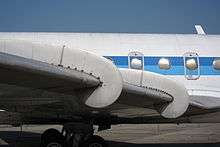
| Variant | Length | Engines | Passengers |
|---|---|---|---|
| Caravelle I | 32.01 m (105 ft 0 in) | RA-29 Mk.522 | 80 |
| Caravelle IA | 32.01 m (105 ft 0 in) | RA-29 Mk.522A | 80 |
| Caravelle III | 32.01 m (105 ft 0 in) | RA-29 Mk.527 and 527B | 80 |
| Caravelle VI-N | 32.01 m (105 ft 0 in) | RA-29 Mk.531 and 531B | 80 |
| Caravelle VI-R | 32.01 m (105 ft 0 in) | RA-29 Mk.533R | 80 |
| Caravelle 10R | 32.01 m (105 ft 0 in) | P&W JT8D-7 | 80 |
| Caravelle 11R | 32.71 m (107 ft 4 in) | P&W JT8D-7 | 89–99 |
| Caravelle 10B | 33.01 m (108 ft 4 in) | P&W JT8D-7 | 105 |
| Caravelle 12 | 36.24 m (118 ft 11 in) | P&W JT8D-9 | 140 |
- Caravelle I
- Similar to the original prototypes; first flew on 14 May 1958. This variant was powered by two Rolls-Royce RA-29 Avon Mk.522 with 4,763 kgf (46,710 N; 10,500 lbf) of unitary thrust and a capacity of 80 passengers. The French certification was obtained on 2 April 1959, and the FAA certification was obtained six days later. The first revenue flight took place that year with Air France on the Paris-Rome-Athens–Istanbul route. Air France Caravelle F-BHRB "Lorraine" was introduced in the Paris-London route on 27 July 1959.
- Sales: 20 were sold; to Air France (10), SAS (6), Air Algérie (2), and VARIG (2). One of the VARIG aircraft was leased by Sud to Air Vietnam and Middle East Airlines before delivery to Royal Air Maroc. In Australia, TAA had planned to re-equip with the Caravelle but as Ansett felt this was too advanced at that stage for their own needs, both airlines were required to purchase the Ansett preference; the less advanced turbo-prop Lockheed L-188 Electra.
- Caravelle IA
- This variant had the same external configuration as variant I but with more powerful engines, the Rolls-Royce Avon RA-29/1 Mk.526 giving improved capabilities. The first flight took place on 11 February 1960. Caravelle I and IA aircraft were later converted to the III variant.
- Sales: 12 built. Deliveries were to Air France, SAS, Air Algérie, Finnair, and Royal Air Maroc.
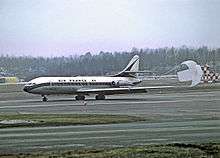
- Caravelle III
- Later improvements to the Avon led to the Caravelle III. It first flew on 30 December 1959, entering service with Alitalia in April 1960. The Caravelle III was powered with Rolls-Royce Avon RA-29/3 Mk.527 and RA-29/3 Mk.527B engines, both with 5,170 kgf (50,700 N; 11,400 lbf) of unitary thrust.
- Sales: The Series III was the best-selling Caravelle with 78 built. Of the 32 Series I, 31 were upgraded to Series III standard. Air Inter used 16 of this type for its domestic routes. Major deliveries were to Air France, as well as aircraft for Swissair, Alitalia, SAS, and Royal Air Maroc.
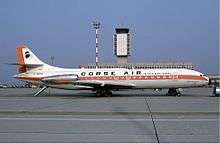
- Caravelle VI-N
- N standing for "normal".[5] A version with more powerful Avon RA-29/6 Mk 531 and RA 29/6 Mk 531B with 5,535 kgf (54,280 N; 12,200 lbf) of unitary thrust engines. The capabilities were improved and the weights increased; the actual payload was reduced. The Caravelle VI-N first flew on September 10, 1960 beginning service with Sabena (Belgium) on January 1961. Of the 78 Series III, 5 were upgraded to Series VI N.
- Sales: 53 built. Deliveries to Saeta, Corse Air, Europe A.S., Minerve, Pushpaka Aviation and Yugoslav Airlines.
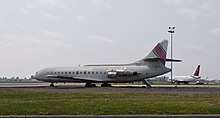
- Caravelle VI-R
- First Caravelle with thrust reversers. The cockpit windows were made larger with redesigned layout and more powerful brakes were introduced. It first flew on February 6, 1961, obtaining FAA certification on June 5 that same year. It began service with United Airlines on July 14. Dash-6R was powered by Avon Ra-29 Mk. 533R and Mk 535R (R, for Reverse) with a unitary thrust of 5,715 kgf (56,050 N; 12,600 lbf).
- Sales: 56 built, 20 for United Airlines. Other series VI customers included Indian Airlines (9), Panair do Brasil (4), Cruzeiro do Sul, Iberia Líneas Aéreas De España (4), LAN Chile (3), Aerolíneas Argentinas (3), TAP Portugal (3). This was also used by Filipinas Orient Airways , Aerocesar, Airborne Express and SA Nacionales.
- Caravelle VII
- This was a Series III, (c/n 042), which was purchased by General Electric, ferried to the United States as Santa Marian 9 and equipped with General Electric CJ805-23 aft-fan engines, becoming, in effect, the engine test-bed for the Caravelle 10A. Flight tests with the new engines began on 29 December 1960 and a second aircraft was planned to be converted, (c/n 063), but this aircraft became the sole Caravelle 10A.
- Caravelle 10A
- Based on the Series VII, but intended for the US market, the 10A was 1 metre (3 ft 3 in) longer than the Series VI, with the windows located 200 mm (7.9 in) higher on the fuselage. The sole prototype was powered by two 71.62 kN (16,100 lbf) General Electric CJ-805-23C aft-fan engines and flew for the first time on 31 August 1962. A modified wing with improved flaps was fitted to meet FAA requirements, as was an auxiliary power unit (APU) in the rear fuselage. However TWA cancelled its order for 20 aircraft due to financial problems, and by the time TWA was in a position to purchase new aircraft, the Douglas DC-9 was preferred. After testing the prototype was scrapped
- Caravelle 10B (Super Caravelle)
- Based on the Series 10A, this variant offered many modifications in respect to other series. It introduced the leading edge extension (a fillet added to the front of an aircraft wings in order to provide usable airflow at high angles of attack). The wing mounted split flaps and the fuselage was extended 1.40 m (4 ft 7 in), with an increase in passenger capacity to 105. The engines used were the new Pratt & Whitney JT8D turbofan engines with 6,350 kgf (62,300 N; 14,000 lbf) of unitary thrust. The 10B first flew on August 31, 1964 and was produced as a run of 22 aircraft.
- Sales: launch customer[8] and primary operator of the 10B was Finnair with 8 examples. Aviaco ordered 5 but this was cancelled, with those aircraft going to Sterling Airways, LTU, and Iberia Airlines. Alia and UTA also acquired aircraft. The last operational Caravelle was a Type 3 10B which flew with Waltair until 2005.[9]
- Caravelle 10R
- A combination of the 10B's engines on the Series VI-R fuselage, creating a smaller but higher powered plane. Maximum weight at take-off was increased to 52,000 kg (115,000 lb) (6,000 kg or 13,000 lb more than the Series I and 2,000 kg or 4,400 lb more than the Series VI-R). It first flew on January 8, 1965 and received the FAA certification on May 23 of that same year.
- Sales: 20 were built, starting service with Alia on July 31, 1965. It also flew with Aero Lloyd, CTA, Hispania and SAT, among others.
- Caravelle 11R
- The 11R had a fuselage length of 31.72 m (104 ft 1 in) (70 cm or 28 in more than other variants) and incorporated a 3.32 m × 1.84 m (10.9 ft × 6.0 ft) cargo door in the port side. This enabled it to carry a mixed load of passengers and cargo. First flight of the series 11R was on April 21, 1967.
- sales: Only 6 planes were built and delivered to Air Afrique, Air Congo, and Transeuropa of Spain.
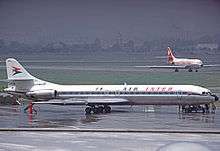
- Caravelle 12 (Super Caravelle)
- This was the last version of the Caravelle to appear, the most advanced of them all, which first flew on March 12, 1971. The Series 12 was a 10B with a noticeably longer fuselage, stretched by 3.2 m (10 ft 6 in), and a newer uprated version of the JT8D engines with 6,577 kgf (64,500 N; 14,500 lbf) of unitary thrust. This allowed for up to 140 passengers over a reduced range. The 12 was aimed primarily at the charter market, produced to 12 examples starting in 1972. By this point Concorde was in production; this design was originally known in France as Sud Aviation Super-Caravelle. The 12 was often referred to by this name.
- Sales: Launch customer for the Series 12 was Sterling Airways with 7 delivered, while the remaining 5 went to Air Inter. Series 12s flew in Europe until October 1996, and in Africa until recently.
Operators
Civil operators
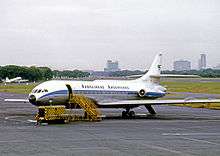
- Aerolíneas Argentinas (1962–1973)[11]
- Alisardia[24]
- Aviaction[13]
- Sterling Airways[15]
- Aerotour[22]
- Air Charter International[19]
- Air France[19]
- Air Inter[29]
- Air Provence
- Catair[13]
- Corse Air
- Euralair[26]
- Europe Aero Service[30]
- Minerve[31]
- Trans-Union[32]
- Union des Transports Aeriens[18]
- Aero Lloyd (1980)[11]
- LTU[20]
- Lufthansa (leased)[34]
- Panair (leased)[31]
- Special Air Transport[35] (SAT)
- Air Liban[37]
- Middle East Airlines[34]
- Filipinas Orient Airways[26]
- Sterling Philippines Airways[40]
- Transasian Airways[39]
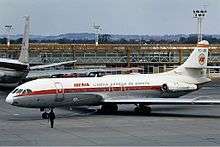

- Istanbul Airlines[45]:98
- Midwest Air Charter[34]/Airborne Express
- United Airlines[44]
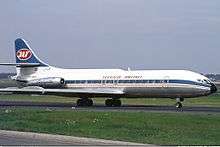
Military and government operators
- Argentine Air Force (1973–1975)[49]
- Central African Empire/Republic Government (1970–1979)[50]
- Chad Government[51]
- Gabon Government (1976–1978)[53]
- Mauritanian Government[53]
- Rwanda Government[53]
- Senegal Government[51]
Incidents and accidents
- 19 January 1960 – Scandinavian Airlines System Flight 871, a Caravelle I, crashed at Esenboga Airport, Turkey due to excessive descent for reasons unknown. Seven crew members and 35 passengers lost their lives.
- 12 September 1961 – Air France Flight 2005, a Caravelle III, crashed near Rabat after the crew misread instruments, killing all 77 on board.
- 27 September 1961 – Varig Flight 592-J, a Caravelle III, crashed when landing at Brasília International Airport, Brasília, Brazil, caught fire and was totally destroyed. Despite this, there were no casualties. Among the passengers were the governor of the Rio Grande do Sul state, Leonel Brizola, and three ministers of state of the newly sworn president João Goulart. This was the first air accident in the new Brazilian capital, founded only 16 months before.[55]
- 4 September 1963 – Swissair Flight 306 crashed shortly after take-off from Zürich following an in-flight fire, killing all 80 people on board.
- 18 April 1964 – Middle East Airlines Flight 444 (OD-AEM) crashed at night into the Persian Gulf, 10 miles out from Dhahran Airport, Saudi Arabia, killing all 49 on board; the cause was never determined.[56]
- 15 February 1966 – An Indian Airlines Caravelle VIN (VT-DPP) crashed short of the runway at Palam Airport in poor visibility, killing two of 80 on board.
- 4 September 1966 – An Indian Airlines Caravelle VIN (VT-DSB) struck a hill at 800 feet during a training flight, killing the four crew.
- 30 June 1967 – Thai Airways International Flight 601, a Caravelle III, crashed into the sea while landing at Hong Kong's Kai Tak Airport during a tropical heavy rainstorm. The co-pilot, who was flying the aircraft, allegedly made an abrupt heading change, causing the aircraft to enter into a high rate of descent and crashing into the sea, to the right of the runway. The starboard wing broke off and the aircraft lay on its starboard side, the port wing tip protruding from the water. 24 were killed probably because half the escape doors were made useless when the aircraft rolled onto its side.[57]
- 4 November 1967 – Iberia Airlines Flight 062, a Caravelle 10R, struck Blackdown Hill, Sussex, United Kingdom, killing all 37 passengers and crew.
- 11 September 1968 – Air France Flight 1611, a Caravelle III en route from the island of Corsica to Nice, France, crashed into the Mediterranean Sea off Nice following an in-flight fire, killing all 95 on board; in 2011 a report surfaced that a missile may have shot down the aircraft.
- 28 December 1968 – Two Middle East Airlines Caravelle VIN's (OD-AEE and OD-AEF), along with 12 other aircraft, were destroyed at Beirut International Airport by Israeli commandos in retaliation for a terrorist attack on a Boeing aircraft in Athens.
- 26 July 1969 – An Air Algérie Caravelle VIN (7T-VAK) crashed at near Hassi Messaoud Airport, Algeria killing 33 passengers and crew out of 37. The aircraft crashed onto the runway while attempting an emergency landing due to an in-flight fire.
- 8 October 1969 – A Cruzeiro do Sul Sud Aviation SE-210 Caravelle VI R en route from Belém-Val de Cães to Manaus-Ponta Pelada was hijacked by 4 people who demanded to be flown to Cuba. The hijacking lasted less than a day and there were no casualties.
- 1 April 1970 – A Royal Air Maroc Caravelle III (CN-CCV) crashed on approach to Casablanca following a loss of control, killing 61 of 72 on board.
- 20 November 1971 – China Airlines Flight 825, a China Airlines Caravelle III (B-1852) crashed near Penghu, Taiwan due to a possible bomb explosion, killing all 25 passengers and crew on board.
- 7 January 1972 – Iberia Airlines Flight 602 crashed into a mountain while on approach to Ibiza Airport, Spain. All 104 passengers and crew were killed.
- 14 March 1972 – Sterling Airways Flight 296 crashed 20 mi west of Kalba, United Arab Emirates due to pilot error, killing all 112 passengers and crew in the worst ever accident involving the Caravelle. The accident is also the deadliest in the United Arab Emirates.
- 1 June 1973 – Cruzeiro do Sul Flight 109, a Caravelle VIN (PP-PDX) from Belém-Val de Cans to São Luís crashed on approach to São Luís. Engine no.1 lost power and the aircraft attained an extreme nose-up attitude. It stalled and crashed 760 m to the right of the runway. All 23 passengers and crew died.[58][59]
- 13 August 1973 – Aviaco Flight 118 crashed near A Coruña, Spain, killing all 85 passengers and crew, while attempting to land at Alvedro Airport (now A Coruña Airport) in heavy fog.
- 11 September 1973 – JAT Airways Flight 769, a Caravelle VIN, struck Babin Zub Peak while on approach to Titograd Airport, killing all 41 passengers and crew on board. The accident remains the worst in Montenegro.
- 22 December 1973 – A Sobelair (but operating for Royal Air Maroc) Caravelle VIN (OO-SRD) struck Mount Mellaline while on approach to Tangier Airport, killing all 106 passengers and crew on board.
- 15 March 1974 – A Sterling Airways Caravelle 10B3 experienced a landing gear failure as it was taxiing for take-off in Tehran's Mehrabad International Airport leading to 15 passengers being killed and 37 passengers and crew injured.
- 12 October 1976 – Indian Airlines Flight 171, a Caravelle VIN, crashed at Santacruz Airport following a loss of control caused by an uncontained engine failure and in-flight fire, killing all 95 on board.
- 18 December 1977 – SA de Transport Aérien Flight 730 crashed into the sea while on final approach to Madeira Airport due to pilot error, killing 36 of 52 on board; the wreckage was found in 2011.
- 30 September 1978 – A Finnair Caravelle was hijacked by an unemployed home building contractor, carrying a gun. With 44 passengers and 5 crew on board the plane flew to Amsterdam, Netherlands. After that they flew to Helsinki, where the hijacker released his hostages and received his demanded money. They then flew to Oulu, where he was arrested at his house the following day.
- 19 June 1980 - An Airborne Express Caravelle VI-R (N905MW) crashed at Atlanta Hartsfield Airport on approach to runway 26. Probable cause listed as poorly planned approach, vortex turbulence, and failure to follow approved procedures, directives, etc.[60]
- 21 December 1980 – A Transportes Aereos del Caribe Caravelle VIR (HK-1810) crashed near Rio Hacha, Colombia due to an explosion and in-flight fire, killing all 70 on board. The cause of the explosion was unknown, but it possibly was a bomb.
- 18 January 1986 – An Aerovias Caravelle temporarily leased from Ecuador's SAETA, crashed in the jungle after missing its first approach, killing all 93 occupants. The flight had originated in Guatemala City and was to land at Mundo Maya International Airport in the northern department of Petén.
Aircraft on display
- Europe
- F-BHRA Caravelle III (msn. 1) Originally delivered to Air France as "Alsace." Preserved at the Piet Smedts Autobedrijf in Baarlo, Netherlands.
- F-BHHI Caravelle III (msn. 2) Second prototype – briefly appeared in Air France color scheme but never flew with the airline. Forward fuselage preserved at the Musée de l'Air et de l'Espace at Paris, Le Bourget.
- LN-KLH Caravelle III (msn. 3) Originally delivered to SAS as "Finn Viking." Preserved at the Norwegian Museum of Science and Technology, Oslo, Norway.[61]
- SE-DAA Caravelle III (msn. 4) Originally delivered to SAS as "Eskil Viking." Stored without nose at Stockholm Arlanda Airport, Sweden and used for fire training. The nose section is in poor condition at the Finnish Aviation Museum, Helsinki.
- One Caravelle, SE-DAI, is located at the Stockholm Arlanda Airport. The aircraft engines are run regularly to keep all systems working until funds covering a "Grand Visit" (=C-check) can be found. The aircraft is maintained by "Le Caravelle Club".[62] Ex-Swedish Air Force Tp85 tail number 852. The cabin is restored to civil standard with SAS 1970 seats in a spacious 2+2 configuration.
- LN-KLP Caravelle III (msn. 24) Originally delivered to SAS as "Trond Viking." Stored as a fire training airframe in poor condition at Malmö - Sturup airport, Sweden.
- PH-TRO Caravelle III (msn. 33) Originally delivered to Transavia Holland. Nose section preserved at the Aviodome, Lelystad, Netherlands.
- OY-KRD Caravelle III (msn. 47) Originally delivered to SAS as "Ulf Viking." Entire aircraft on display at the Danish Museum of Science & Technology, Helsingør, Denmark.[63]
- F-BHRT Caravelle III (msn. 55) Originally delivered to Air France as "Picardie." Entire aircraft preserved, serving as an instructional airframe at the Institute Amaury de la Grange, a technical college and flying school at Merville-Calonne, France.
- 57 Caravelle III (msn. 57) Originally delivered to Royal Air Maroc as CN-CCX. On display at Musée Européen de l'Aviation de Chasse, Montélimar, France.
- F-BHRU Caravelle III (msn. 58) Originally delivered to Air France as "Poitou." Nose section acquired by private individual. Being converted to Simulator in Oberschleißheim, Munich, Germany.
- F-BHRY Caravelle III (msn. 61) Originally delivered to Air France as "Touraine." On display at Albert, France.
- OO-SRA Caravelle VI-N (msn. 64) Originally delivered to Sabena. Entire aircraft preserved at the Royal Museum of the Armed Forces and Military History, Brussels, Belgium.
- EL-AIW Caravelle VI-N (msn. 106) Originally delivered to Alitalia as I-DABS, "Dubhe." Stored in poor condition at Makedonia Airport, Thessaloniki, Greece, after having been impounded for weapon smuggling.
- SE-DAF Caravelle III (msn. 112) Originally delivered to SAS as "Sven Viking." Stored at Stockholm Arlanda Airport, Sweden.
- F-ZACE Caravelle III (msn. 116) Originally delivered to Finnair as OH-LED and flown by the French Air Force as 116/CE. On display at Musée Européen de l'Aviation de Chasse, Montélimar, France.
- F-BJTH Caravelle III (msn. 124) Originally delivered to Air France as "Franche-Comté"; later served with Air Charter International. Stored along the eastern perimeter of Nice airport (43°40′24″N 7°13′38″E / 43.6732°N 7.2271°E). Close by is the monument to the September 1968 accident when a Caravelle crashed with the loss of all on board.
- YU-AHB Caravelle VI-N (msn. 135) Originally delivered to JAT Yugoslav Airlines as "Bled." On display at the Museum of Yugoslav Aviation, near the Nikola Tesla International Airport.
- F-RAFG Caravelle III (msn. 141) Originally delivered to the French Air Force as the presidential aircraft for Charles de Gaulle. Stored, awaiting restoration at Musée de l'Air et de l'Espace (Paris Museum of Air and Space in Le Bourget).
- I-DABM Caravelle VI-N (msn. 143) Originally delivered to Alitalia. On display but in poor condition at Ceolini, Italy.
- F-BJTO Caravelle III (msn. 148) Originally delivered to Air France as "Pays Basque"; later transferred to Air Charter International. Nose section preserved at the Air France Technical School in Vilgenis, near Paris, France.
- SE-DAG Caravelle III (msn. 172) Originally delivered to SAS as "Dag Viking." Currently on display at the Swedish Air Force Museum, Linköping. The aircraft served with the Swedish Air Force (tail number 851) for signal reconnaissance.[64]
- F-BJEN Caravelle 10R Super B (msn. 185) Originally delivered to Finnair as OH-LSC "Turku". Forward fuselage section preserved Corlier, France, as "Aeroclub du Haut-Bugey".
- SE-DAI Caravelle III (msn. 210) Originally delivered to SAS as "Alrik Viking." Fully restored and preserved as Le Caravelle Club at Stockholm - Arlanda airport, Sweden.
- F-BVPZ Caravelle VI N (msn. 218) Originally delivered to JAT Yugoslav Airlines as YU-AHF and flown by Corse Air. Displayed in the colors of Athis-Paray Aviation at the Musée Delta in Athis-Mons, near Paris-Orly Airport.[65]
- F-BYCY Caravelle 12 (msn. 233) Originally delivered to JAT Yugoslav Airlines as YU-AHG and flown by Aerotur and Corse Air. Preserved at Moyenpal, France, as a karaoke bar "Espace Caravelle".
- F-ZAZQ Caravelle VI-R (msn. 234) Originally delivered to Luxair as LX-LGE. This aircraft was used for microgravity with the Conservatoire de l'Air et de l'Espace d'Aquitaine; now retired, she has been preserved at Bordeaux-Merignac.
- F-BOHA Caravelle III (msn. 242) Originally delivered to Air France as "Guyane." Stored and on display at Avignon, France.
- F-GHMU Caravelle 12 (msn. 249) Originally delivered to Sterling Airways as OY-STE before being sold to Air Toulouse International; also flew for Air City as HB-IKD and the government of the Central African Republic as TL-ABB and European Air Service as F-GCJT. Preserved and on display at the Ailes Anciennes de Toulouse Museum at Toulouse-Blaganc, France.
- TC-ABA Caravelle 10B (msn. 253) Originally delivered to SATA as HB-ICN. Sold to Istanbul Airlines, named "Mine." Restored and on display at the Istanbul Aviation Museum, Turkey.
- F-GCVM Caravelle 12 (msn. 270) Originally delivered to Sterling Airways as OY-SAA and flown by Air Inter and Air Provence. Stored in poor condition at Marseilles-Provence Airport, Marignane, France.
- F-GCVL Caravelle 12 (msn. 273) Originally delivered to Sterling Airways as OY-SAE and flown by Air Inter and Air Provence. Preserved and on display at Musée de l'Air et de l'Espace (Paris Museum of Air and Space in Le Bourget).[66]
- F-GVCK Caravelle 12 (msn. 276) Originally delivered to Air Inter. Preserved at the [Institut Aéronautique Amaury de la Grange], [Merville – Calonne], France.
- F-BTOE Caravelle 12 (msn. 280) Originally delivered to Air Inter, the last Caravelle built. Preserved and on display at the Aeroscopia Museum at Toulouse-Blagnac Airport, France.[67]
- The cockpit of an unidentified Caravelle rests at a company in Velbert, Germany, that makes flight simulators.
- North America
- N901MW Caravelle VI-R (msn. 62) Originally built for United Air Lines but purchased by Serviços Aéreos Cruzeiro do Sul PP-CJC, before being sold to Airborne Express. This aircraft is located at Port Columbus Airport (CMH) in Columbus, Ohio, USA. After the closure of the Ohio History of Flight Museum, to which it belonged, it was donated to Port Columbus Airport Authority and is currently used by fire teams for training. The airframe was reported in storage in 2006, but now sits outside of the Port Columbus Airport Fire Department with the radome removed.
- N1001U Caravelle VI-R (msn. 86) Originally delivered to United Air Lines. Preserved at the Pima Air & Space Museum in Tucson, Arizona in Aero Service markings.
- N777VV Caravelle VI-R (msn. 87) Originally with United Airlines as N1002U, "Ville de Cahors." Sold to Transavia Holland as PH-TRY, before returning to the US with Turbo Air Holdings and later donated to Pima County College. In poor condition at Tucson International Airport as a fire trainer.
- HK-2836 Caravelle 10R (msn. 211) Originally delivered to Finnair as "Kuopio." Also flew for Air Charter and EAS - Europe Aero Service as F-GDFZ before being sold to SEC Colombia as HK-3836 and LAS - Lineas Aereas Suramericanas as HK-3836X, going on to serve with the Fuerza Aerea Mexicana, serial 10506. This aircraft was impounded at MEX, again wearing serial HK-3836. She was eventually moved and re-assembled for visitor display inside Parque Aviacuatico Los Manantiales, Jilotepec-Ixtlahuaca Highway at km 39. Sistership Fuerza Aerea Mexicana, serial 10507 (msn. 232) may have survived a number of years at a Mexican water park north of Mexico City, but is believed to have finally been scrapped in 2002.
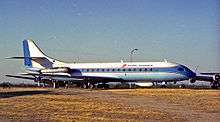
- South America
- HC-BDS Caravelle VI-N (msn. 146) Originally delivered to Alitalia as I-DABV. Last flew for Sociedad Anónima Ecuatoriana de Transportes Aéreos in Ecuador. Sold to a private individual in 1990 and moved to Otavalo and repainted in fictitious "Pastavi Airlines" markings. Last photographed in 2004, probably still existent.
- Africa
- I-DABA Caravelle VI-N (msn. 71) Originally with Alitalia, before being sold to the Congo as 9Q-CRU. Repainted and on display at as the "Aero Beach Craft" park and bufffet near Entebbe, Uganda.
- CN-CCZ Caravelle (msn. 195) Originally with Royal Air Maroc. Stored at the Royal Air Maroc training facilities at Mohammed V International Airport in Casablanca.[68]
- Asia
- XU-JTB Caravelle III (msn. 53) Originally with Air France as F-BJTA, "Compte de Nice," later renamed "Antilles." Later sold to Air Cambodge and stored at Bangkok International, Thailand, in derelict condition.
Specifications (Caravelle III)

Data from Lopez[3]
General characteristics
- Crew: 3
- Capacity: 80 (or 89+, as in Flight AF1611, 1968)[69]
- Payload: 8.4 t (9.3 short tons)
- Length: 31.01 m (101.7 ft)
- Wingspan: 34.3 m (112 ft 6 in)
- Height: 8.72 m (28.61 ft)
- Wing area: 146.7 m² (1,579 sq ft)
- Airfoil: Swept wing at 1/4 of the chord line: 20°
- Empty weight: 22.2 t (24.5 sT)
- Max. takeoff weight: 46 t (50.7 sT)
- Powerplant: 2 × Rolls-Royce Avon Mk.527 turbojet, 50.7 kN (11,400 lbf) each
Performance
- Maximum speed: 805 km/h (500 mph/435 knots)
- Range: 1,700 km (920 nmi/1,060 mi)
- Service ceiling: 12,000 m (39,370 ft)
See also
Related development
Aircraft of comparable role, configuration and era
Related lists
References
Citations
- ↑ "The Sud SE-210 Caravelle". Airliners.net. Retrieved 4 May 2013.
- ↑ "Airliner price index". Flight International. 10 August 1972. p. 183.
- 1 2 3 4 5 6 7 8 9 10 11 12 13 14 15 16 López Ortega, Antonio (1999). Reactores comerciales: Dibujos del autor (in Spanish). Madrid: Agualarga. ISBN 978-84-95088-87-1. OCLC 47809267.
- 1 2 3 4 5 6 7 8 9 10 11 12 Dougal 1963, p. 456.
- 1 2 3 4 5 6 7 Dougal 1963, p. 457.
- 1 2 Dougal 1963, p. 458.
- 1 2 Dougal 1963, pp. 456–457.
- ↑ "Reittilentoliikenteen ensimmäinen Super Caravelle luovutettiin Suomeen" [The first Super Caravelle for scheduled flights was delivered to Finland]. Helsingin Sanomat (in Finnish). 26 July 1964. p. C 18 (2014).
- ↑ "Caravelle the Complete Story" (PDF). Archived from the original (pdf) on 2016-11-27.
- 1 2 3 Avrane 1981, p. 47.
- 1 2 Avrane 1981, p. 44.
- 1 2 3 Avrane 1981, p. 62.
- 1 2 3 Avrane 1981, p. 68.
- 1 2 Avrane 1981, p. 87.
- 1 2 Avrane 1981, p. 92.
- 1 2 Avrane 1981, p. 69.
- 1 2 3 4 Avrane 1981, p. 86.
- 1 2 Avrane 1981, p. 99.
- 1 2 3 Avrane 1981, p. 48.
- 1 2 3 Avrane 1981, p. 75.
- 1 2 Avrane 1981, p. 46.
- 1 2 Avrane 1981, p. 45.
- 1 2 3 Avrane 1981, p. 95.
- 1 2 3 Avrane 1981, p. 61.
- 1 2 3 Avrane 1981, p. 90.
- 1 2 3 4 Avrane 1981, p. 71.
- 1 2 Avrane 1981, p. 72.
- 1 2 3 4 Avrane 1981, p. 74.
- ↑ Avrane 1981, p. 51.
- 1 2 Avrane 1981, p. 70.
- 1 2 Avrane 1981, p. 85.
- 1 2 Avrane 1981, p. 97.
- 1 2 Avrane 1981, p. 50.
- 1 2 3 4 Avrane 1981, p. 84.
- 1 2 Avrane 1981, p. 91.
- ↑ Avrane 1981, p. 73.
- 1 2 3 4 Avrane 1981, p. 52.
- ↑ "World Airline Directory". Flight International. 133 (4106). 1988-03-26. Retrieved 14 April 2009.
- 1 2 3 Avrane 1981, p. 96.
- ↑ Avrane 1981, p. 93.
- 1 2 Avrane 1981, p. 63.
- 1 2 Avrane 1981, p. 94.
- ↑ Guttery 1998, p. 211.
- 1 2 Avrane 1981, p. 98.
- ↑ de:Istanbul Airlines
- ↑ Avrane 1981, p. 100.
- ↑ "World Airlines Directory". Flight International. 22 March 1973. p. 440.
- ↑ Avrane 1981, p. 119.
- ↑ Avrane 1981, p. 113.
- ↑ Avrane 1981, p. 112.
- 1 2 Avrane 1981, p. 117.
- ↑ Avrane 1981, p. 101.
- 1 2 3 Avrane 1981, p. 116.
- 1 2 Avrane 1981, p. 115.
- ↑ "ACIDENTES E INCIDENTES AÉREOS NO BRASIL E NO MUNDO".
- ↑ "MEA Caravelle Lost", Flight International: 635, 24 April 1964
- ↑ "Accident Database". Archived from the original on 2012-11-04.
- ↑ "Accident description PP-PDX". Aviation Safety Network. Retrieved 22 June 2011.
- ↑ Germano da Silva, Carlos Ari César (2008). "O mistério do Tirirical". O rastro da bruxa: história da aviação comercial brasileira no século XX através dos seus acidentes 1928–1996 (in Portuguese) (2 ed.). Porto Alegre: EDIPUCRS. pp. 279–284. ISBN 978-85-7430-760-2.
- ↑ https://aviation-safety.net/database/record.php?id=19800619-1
- ↑ "Kulturnett.no – Kultur i Norge på nett" (in Norwegian). Museumsnett.no. Retrieved 8 February 2012.
- ↑ "Preserving a classic airliner". Le Caravelle Club. Archived from the original on 1999-11-28. Retrieved 2012-02-08.
- ↑
- ↑ "Sud Aviation SE-210 Caravelle III". www.flygvapenmuseum.se. Retrieved 24 July 2017.
- ↑ "Caravelle at Musée Delta". Museedelta.free.fr. Retrieved 8 February 2012.
- ↑ "Présentation> Musée de l'Air et de l'Espace – Site officiel". Mae.org. Retrieved 8 February 2012.
- ↑ "List of displayed aircraft - Aeroscopia official website".
- ↑ "Photo Royal Air Maroc (RAM) Sud Aviation SE-210 Caravelle CN-CCZ". Planepictures.net. 1 February 2006. Retrieved 8 February 2012.
- ↑ Rapport Finale sur l'accident survenu le 11 septembre 1968 au large du cap d'Antibes au SE 210 F-BOHB, (PDF) Archived 10 April 2012 at WebCite BEA, 14 December 1972. From the BEA website. Retrieved 11 September 2011.
Bibliography
- Avrane, Alexandre; Gilliand, Michel; Guillem, J. (1981). Sud Est Caravelle. London: Jane's. ISBN 978-0-7106-0044-8. OCLC 9363786.
- "Progress with the Caravelle" (pdf), Flight: 472–473, 24 September 1954
- "Caravelle" (pdf), Flight: 31–33, 6 July 1956
- Dougal, M. G. (12 September 1963), "The Caravelle: Past Present and Future" (pdf), Flight International: 456–458
- Caravelle the Complete Story (PDF), archived from the original (pdf) on 2016-11-27
External links
| Wikimedia Commons has media related to: |
- Video in YouTube about TALCE's operations in Africa, showing (among other aircraft) Caravelle 3D-KIK (accessed 2009-05-12)
- SudAviation.com – the Caravelle website (accessed 2012-09-11)
- "Flying the Caravelle" a 1957 Flight article
- YouTube video of a United Air Lines SE210 Caravelle
- Max Kingsley-Jones (December 8, 2016). "How Sud's Caravelle powered Europe's airliner charge".